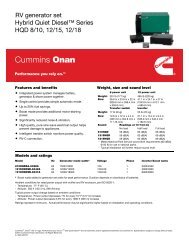Air Brake Manual
Air Brake Manual
Air Brake Manual
Create successful ePaper yourself
Turn your PDF publications into a flip-book with our unique Google optimized e-Paper software.
Mechanical Release (Caging)<br />
Some spring parking brakes can be released<br />
mechanically by “winding them off” or “caging”<br />
them. Caging means the brakes are being released.<br />
This is achieved with a bolt that runs through the<br />
centre of the chamber body, which is turned to<br />
compress the spring. It may be necessary to first<br />
remove a lock plate and stud to gain access to the<br />
head of the bolt. Other types have a dust cap that<br />
must first be removed and a bolt inserted. In some<br />
cases, a special wrench is required. Instruction on<br />
how to “cage” is usually on the body of the parking<br />
brake chamber. If all air is lost and the vehicle has to<br />
be towed, the parking brakes can be released by<br />
caging them. Always block the wheels when caging<br />
the parking brake spring.<br />
Warning<br />
Spring parking brake chambers should never be<br />
disassembled without first compressing the spring<br />
with a caging bolt. These springs are under extreme<br />
pressure and could cause serious personal injury if<br />
disassembly is attempted by anyone not<br />
experienced in servicing these units. Disassembly of<br />
a spring brake chamber should only be preformed<br />
by a qualified mechanic or technician.<br />
Slack<br />
adjuster<br />
Parking <strong>Brake</strong> Spring Caged<br />
<strong>Brake</strong>s Off<br />
Mounting Bolts<br />
Clevis and pin<br />
Service brake<br />
chamber<br />
Push rod<br />
Diaphragm<br />
return<br />
spring<br />
Diaphragm<br />
Parking brake<br />
spring<br />
Caging<br />
bolt<br />
Spring parking<br />
brake chamber<br />
Section Summary Questions<br />
1. What is meant by “compounding” the brakes<br />
2. Why are spring brakes a reliable type of parking<br />
brake<br />
3. How are parking brakes held in the released<br />
position<br />
4. What are the functions of the cab-mounted<br />
parking brake control valve<br />
5. Will parking brakes apply “automatically” in<br />
all braking systems<br />
6. What is the reason for releasing the parking<br />
brakes before making a full brake application<br />
test<br />
7. Why must you be careful parking a vehicle with<br />
overheated brakes<br />
8. How can some types of parking brakes be<br />
released without the use of air pressure<br />
9. What is the danger of disassembling a spring<br />
parking brake unit<br />
35




